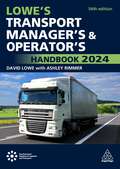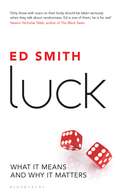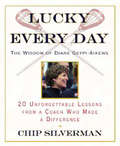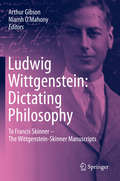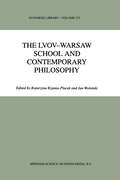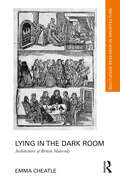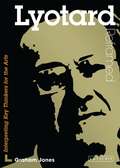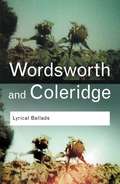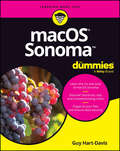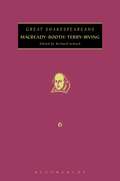- Table View
- List View
Low vision toolkit: supporting pupils with low vision (PDF)
by Nathan DaviesThe Low vision toolkit is a training programme to teach pupils with low vision how to make the most of their sight and how to use their low vision aids correctly and with confidence. The toolkit also enables the pupils to appreciate that there are many different sources of support, advice and information, including useful websites. The pupils are also encouraged to find out about their eye condition and explain the effects of it to others. The Low vision toolkit has been principally produced for Qualified Teachers of the Visually Impaired (QTVIs) and Learning Support Assistants (LSAs) who support pupils with low vision. However, other professionals who work with children and young people with low vision may also find the information and activities useful.
Lowe's Transport Manager's and Operator's Handbook 2021
by David LoweSupplementary Brexit Trade and Cooperation Agreement Content Available. See inside first page/back cover of the book for access details. Maintain your understanding of the rules governing road transport operators in the UK, Ireland and Europe to ensure the safe and legal operation of your fleet.Lowe's Transport Manager's and Operator's Handbook 2021 is the complete guide to the operational rules and guidelines governing the UK, Ireland and the EU's road transport operators. Written and designed for transport managers, fleet operators, owner-driver hauliers and those working in the sector, this book contains all the relevant and technical detail required to run a compliant, safe and efficient transport operation.Now in its 51st edition Lowe's Transport Manager's and Operator's Handbook 2021 remains an essential resource to stay informed on the most pressing issues facing the transport industry. It covers all aspects relating to goods vehicles and their operators from vehicle registration, maintenance and load management (including abnormal and dangerous loads) to professional competence, operator training and driver testing. Road traffic law is explained alongside how to ensure safety on the road and at work. Meeting operating standards, keeping up to date with the latest industry changes and complying with the law, all while running sustainable transport operations, has never been simpler with the help of this guide.
Lowe's Transport Manager's and Operator's Handbook 2021
by David LoweSupplementary Brexit Trade and Cooperation Agreement Content Available. See inside first page/back cover of the book for access details. Maintain your understanding of the rules governing road transport operators in the UK, Ireland and Europe to ensure the safe and legal operation of your fleet.Lowe's Transport Manager's and Operator's Handbook 2021 is the complete guide to the operational rules and guidelines governing the UK, Ireland and the EU's road transport operators. Written and designed for transport managers, fleet operators, owner-driver hauliers and those working in the sector, this book contains all the relevant and technical detail required to run a compliant, safe and efficient transport operation.Now in its 51st edition Lowe's Transport Manager's and Operator's Handbook 2021 remains an essential resource to stay informed on the most pressing issues facing the transport industry. It covers all aspects relating to goods vehicles and their operators from vehicle registration, maintenance and load management (including abnormal and dangerous loads) to professional competence, operator training and driver testing. Road traffic law is explained alongside how to ensure safety on the road and at work. Meeting operating standards, keeping up to date with the latest industry changes and complying with the law, all while running sustainable transport operations, has never been simpler with the help of this guide.
Lowe's Transport Manager's and Operator's Handbook 2022
by David Lowe Glen DaviesThe United Kingdom has experienced the biggest changes to its freight and transport regulations in a lifetime. Understand the complete rules and processes governing the UK's road transport operators with this guide, including those that have changed with Brexit. Lowe's Transport Manager's and Operator's Handbook 2022 offers a complete overview of the operational rules and guidelines governing the UK's road transport operator. This book contains all the relevant legal and technical information required to run a compliant, safe and efficient transport operation. It includes all the latest changes to the rules and processes, including those governing the transportation of goods between Great Britain and the EU following Brexit.This fully updated 52nd edition remains an essential resource for transport managers, fleet operators, owner-driver hauliers and those working in the sector. It covers all aspects relating to goods vehicles and their operators from vehicle registration, maintenance and load management (including abnormal and dangerous loads) to professional competence, operator training and driver testing. Road traffic law is explained alongside how to ensure safety on the road and at work. Meeting operating standards, keeping up to date with the latest industry changes and complying with the law, all while running sustainable transport operations, has never been simpler with the help of this guide.
Lowe's Transport Manager's and Operator's Handbook 2023
by Glen DaviesLowe's Transport Manager's and Operator's Handbook 2023 provides a complete overview of the operational guidance governing the UK's road transport operators.With the uncertainty of technological advancement, post-Brexit trade arrangements and various industry crises, it is essential for the UK's road transport operators to have a firm grasp of the processes, rules and regulations that govern their industry. This fully updated 53rd edition covers all aspects of transport legislation relating to goods vehicles and their operators from vehicle registration, maintenance and load management to professional competence, operator training and driver testing. Road traffic law is explained alongside how to ensure safety on the road and at work.Meeting operating standards, keeping up to date with the latest industry changes and complying with the law, all while running sustainable transport operations, has never been simpler with the help of Lowe's Transport Manager's and Operator's Handbook 2023. It is an essential resource for transport managers, fleet operators, owner driver haulers and those working in the industry looking to ensure operational stability and legislative compliance in a turbulent environment.
Lowe's Transport Manager's and Operator's Handbook 2024
by David LoweLowe's Transport Manager's and Operator's Handbook 2024 offers crucial guidance on changes within the transport and haulage industry, providing a clear and concise approach to complex rules, processes and regulations affecting practitioners within the sector.This fully updated 54th edition outlines important legal and technical information so that transport managers, fleet operators, hauliers and practitioners can ensure they remain compliant while navigating a continuously evolving sector. Covering the latest changes to UK guidelines, this indispensable guide includes an essential overview of new operational rulings, up-to-date regulatory decisions and key aspects of transport legislation. Lowe's Transport Manager's and Operator's Handbook 2024 is a vital source for those wanting to ensure professional competence and operational stability. From driver testing and training, road traffic law and vehicle maintenance to Brexit-led changes and technological advancements, this highly regarded guide remains an essential resource for ensuring the safe and efficient operation of today's transport industry.
Luciano Floridi’s Philosophy of Technology: Critical Reflections (Philosophy of Engineering and Technology #8)
by Hilmi DemirInformation and communication technologies of the 20th century have had a significant impact on our daily lives. They have brought new opportunities as well as new challenges for human development. The Philosopher: Luciano Floridi claims that these new technologies have led to a revolutionary shift in our understanding of humanity’s nature and its role in the universe. Florodi’s philosophical analysis of new technologies leads to a novel metaphysical framework in which our understanding of the ultimate nature of reality shifts from a materialist one to an informational one. In this world, all entities, be they natural or artificial, are analyzed as informational entities. This book provides critical reflection to this idea, in four different areas: Information Ethics and The Method of Levels of Abstraction The Information Revolution and Alternative Categorizations of Technological Advancements Applications: Education, Internet and Information Science Epistemic and Ontic Aspects of the Philosophy of Information
Luck: What It Means and Why It Matters
by Ed SmithFor aspiring cricketer Ed Smith, luck was for other people. Like his childhood hero, Geoff Boycott, the tough, flinty Yorkshireman, the young Ed knew that the successful cricketer made his own luck by an application of will power, elimination of error, and the relentless pursuit of excellence. But when a freak accident at the crease at Lords prematurely ended Ed Smith's international cricketing career, it changed everything - and prompted him to look anew at his own life through the prism of luck. Tracing the history of the concepts of luck and fortune, destiny and fate, from the ancient Greeks to the present day - in religion, in banking, in politics - Ed Smith argues that the question of luck versus skill is as pertinent today as it ever has been. He challenges us to think again about privilege and opportunity, to re-examine the question of innate ability and of gifts and talents accidentally conferred at birth. Weaving in his personal stories - notably the chance meeting of a beautiful stranger who would become his wife on a train he seemed fated to miss - he puts to us the idea that in life, luck cannot be underestimated: without any means of explaining our differing lots in life, the world without luck is one in which you deserve every ill that befalls you, where envy dominates and averageness is the stifling ideal. Embracing luck leads us to a fresh reappraisal of the nature of success, opportunity and fairness.Bankers have promised 'risk-free' investments, the self-help industry peddles the idea that everyone can pull themselves up by their own bootstraps, and life's winners are encouraged to claim that they did it all themselves in a 'meritocracy'. The case for luck needs to be made now, more than ever.
Lucky Every Day: 20 Unforgettable Lessons from a Coach Who Made a Difference
by Chip SilvermanLoyola college of Maryland Women's Lacrosse Coach Diane Geppi-Aikens would have been a remarkable role model simply as one of the nation's top lacrosse coaches. But this single mother of four battled inoperable brain tumors for eight years. Partially paralyzed and confined to a wheelchair, Geppi-Aikens missed only one game as she coached her #1 ranked team into the semi-finals of the NCAA championships. In spite of the terrible tragedy threatening her life, she managed to get her players to consider her lucky. Now, in the wake of this courageous woman's death comes an incredibly inspirational book. Her unique and uplifting teachings live on through the memories of those she inspired most.
Lucretian Thought in Late Stuart England: Debates About The Nature Of The Soul
by L. LinkerHow did writers understand the soul in late seventeenth-century England? This book considers depictions of the soul in literary texts that engage with Lucretius's Epicurean philosophy in De rerum natura or through the writings of the most important natural philosopher to disseminate Epicurean atomism in England, Walter Charleton (1619-1707).
Ludwig Wittgenstein: To Francis Skinner – The Wittgenstein-Skinner Manuscripts
by Ludwig Wittgenstein Francis SkinnerIn this volume we witness Wittgenstein in the act of composing and experimenting with his new visions in philosophy. The book includes key explanations of the origin and background of these previously unknown manuscripts. It investigates how Wittgenstein’s philosophical thought-processes are revealed in his dictation to, as well as his editing and revision with Francis Skinner, in the latter’s role of amanuensis. The book displays a considerable wealth and variety of Wittgenstein’s fundamental experiments in philosophy across a wide array of subjects that include the mind, pure and applied mathematics, metaphysics, the identities of ordinary and creative language, as well as intractable problems in logic and life. He also periodically engages with the work of Newton, Fermat, Russell and others. The book shows Wittgenstein strongly battling against the limits of understanding and the bewitchment of institutional and linguistic customs. The reader is drawn in by Wittgenstein as he urges us to join him in his struggles to equip us with skills, so that we can embark on devising new pathways beyond confusion. This collection of manuscripts was posted off by Wittgenstein to be considered for publication during World War 2, in October 1941. None of it was published and it remained hidden for over two generations. Upon its rediscovery, Professor Gibson was invited to research, prepare and edit the Archive to appear as this book, encouraged by Trinity College Cambridge and The Mathematical Association. Niamh O’Mahony joined him in co-editing and bringing this book to publication.
Ludwig Wittgenstein: Half-Truths and One-and-a-Half-Truths
by Jaakko HintikkaIF WITI'GENSTEIN COULD TALK, COULD WE UNDERSTAND HIM? Perusing the secondary literature on Wittgenstein, I have frequently experienced a perfect Brechtean Entfremdungseffekt. This is interesting, I have felt like saying when reading books and papers on Wittgenstein, but who is the writer talking about? Certainly not Ludwig Wittgenstein the actual person who wrote his books and notebooks and whom I happened to meet. Why is there this strange gap between the ideas of the actual philosopher and the musings of his interpreters? Wittgenstein is talking to us through the posthumous publication of his writings. Why don't philosophers understand what he is saying? A partial reason is outlined in the first essay of this volume. Wittgenstein was far too impatient to explain in his books and book drafts what his problems were, what it was that he was trying to get clear about. He was even too impatient to explain in full his earlier solutions, often merely referring to them casually as it were in a shorthand notation. For one important instance, in The Brown Book, Wittgenstein had explained in some detail what name-object relationships amount to in his view. There he offers both an explanation of what his problem is and an account of his own view illustrated by means of specific examples of language-games. But when he raises the same question again in Philosophical Investigations I, sec.
Luhmann Observed: Radical Theoretical Encounters
by Anders La CourThis book, for the first time, brings Niklas Luhmann's work into dialogue with other theoretical positions, including Lacan, Derrida, Deleuze, gender studies, bioethics, translation, ANT, eco-theories and complexity theory.
Luigi Moretti: Lessons of SPAZIO (Routledge Research in Architecture)
by Roberto PoddaLuigi Moretti: Lessons of SPAZIO focuses on the theoretical work of the Italian architect Luigi Moretti (Rome, 1906–1973). It does so selectively, focusing on the editorials he published between 1950 and 1953 as editor-in-chief of the magazine SPAZIO, as well as a further essay on parametric architecture, published in 1971–1972, in the first issue of the magazine MOEBIUS, directed by his friend Giulio Roisecco.This book rediscovers Moretti's personal impact on international architectural theory through thoughtful comments that shed light on the architect's modernity and original approach. Although Moretti is an architect renowned for his projects and buildings, his theoretical essays are less well-known. The aim of this book is therefore to explore Moretti's theoretical work, which covers many topics, including pictorial art, sculpture, architecture, urban planning, music, cinema, poetry, mathematics, computer science, parametricity. In addition to the translation from Italian to English, the book contains reproductions of the original articles, accompanied by a series of essays of critical commentary and updated interpretations that show new ways of approaching, reading, and understanding the foundations of current architectural theory and its progress over the last 50 years. This book approaches Moretti's thought from a new perspective, with the aim of reconsidering the originality of this brilliant and visionary architect who was intellectually ostracised for many years due to political and ideological contingencies, even though he personified the ideal of the 'Renaissance man' in modern times.A re-reading of Moretti's work is more justified today than has ever been before, both to reconnect the threads with contemporaneity and to make his intensity and farsightedness of vision known to researchers, teachers, and students working in the areas of architecture and design theory, technology, and art today.
Luigi Moretti: Lessons of SPAZIO (Routledge Research in Architecture)
by Roberto PoddaLuigi Moretti: Lessons of SPAZIO focuses on the theoretical work of the Italian architect Luigi Moretti (Rome, 1906–1973). It does so selectively, focusing on the editorials he published between 1950 and 1953 as editor-in-chief of the magazine SPAZIO, as well as a further essay on parametric architecture, published in 1971–1972, in the first issue of the magazine MOEBIUS, directed by his friend Giulio Roisecco.This book rediscovers Moretti's personal impact on international architectural theory through thoughtful comments that shed light on the architect's modernity and original approach. Although Moretti is an architect renowned for his projects and buildings, his theoretical essays are less well-known. The aim of this book is therefore to explore Moretti's theoretical work, which covers many topics, including pictorial art, sculpture, architecture, urban planning, music, cinema, poetry, mathematics, computer science, parametricity. In addition to the translation from Italian to English, the book contains reproductions of the original articles, accompanied by a series of essays of critical commentary and updated interpretations that show new ways of approaching, reading, and understanding the foundations of current architectural theory and its progress over the last 50 years. This book approaches Moretti's thought from a new perspective, with the aim of reconsidering the originality of this brilliant and visionary architect who was intellectually ostracised for many years due to political and ideological contingencies, even though he personified the ideal of the 'Renaissance man' in modern times.A re-reading of Moretti's work is more justified today than has ever been before, both to reconnect the threads with contemporaneity and to make his intensity and farsightedness of vision known to researchers, teachers, and students working in the areas of architecture and design theory, technology, and art today.
The Lvov-Warsaw School and Contemporary Philosophy (Synthese Library #273)
by Katarzyna Kijania-Placek and Jan WoleńskiLying in the Dark Room: Architectures of British Maternity (Routledge Research in Architecture)
by Emma CheatleLying in the Dark Room: Architectures of British Maternity returns to and reflects on the spatial and architectural experience of childbirth, through both a critical history of maternity spaces and a creative exploration of those we use today. Where conventional architectural histories objectify buildings (in parallel with the objectification of the maternal body), the book—in the mode of creative practice research—presents a creative-critical autotheory of the architecture of lying-in. It uses feminist, subjective modes of thinking that travel across disciplines, registers and arguments. The book assesses the transformation of maternity spaces—from the female bedchamber of seventeenth- and eighteenth-century marital homes, to the lying-in hospitals of the eighteenth and nineteenth centuries purposely built by man-midwives, to the late twentieth-century spaces of home and the modern hospital maternity wing—and the parallel shifts in maternal practices. The spaces are not treated as mute or neutral backdrops to maternal history but as a series of vital, entangled atmospheres, materials, practices and objects that are produced by, and, in turn, produce particular social and political conditions, gendered structures and experiences. Moving across spaces, systems, protagonists and their subjectivities, the book shows how hospital design and protocol altered ordinary birth at home and continues to shape maternal spatial experience today. As such, it will be of interest to a wide range of readers, from architectural historians, theoreticians, designers and students to medical humanities historians, to English Literature, humanities and material studies scholars, as well as those interested in creative-critical writing.
Lying in the Dark Room: Architectures of British Maternity (Routledge Research in Architecture)
by Emma CheatleLying in the Dark Room: Architectures of British Maternity returns to and reflects on the spatial and architectural experience of childbirth, through both a critical history of maternity spaces and a creative exploration of those we use today. Where conventional architectural histories objectify buildings (in parallel with the objectification of the maternal body), the book—in the mode of creative practice research—presents a creative-critical autotheory of the architecture of lying-in. It uses feminist, subjective modes of thinking that travel across disciplines, registers and arguments. The book assesses the transformation of maternity spaces—from the female bedchamber of seventeenth- and eighteenth-century marital homes, to the lying-in hospitals of the eighteenth and nineteenth centuries purposely built by man-midwives, to the late twentieth-century spaces of home and the modern hospital maternity wing—and the parallel shifts in maternal practices. The spaces are not treated as mute or neutral backdrops to maternal history but as a series of vital, entangled atmospheres, materials, practices and objects that are produced by, and, in turn, produce particular social and political conditions, gendered structures and experiences. Moving across spaces, systems, protagonists and their subjectivities, the book shows how hospital design and protocol altered ordinary birth at home and continues to shape maternal spatial experience today. As such, it will be of interest to a wide range of readers, from architectural historians, theoreticians, designers and students to medical humanities historians, to English Literature, humanities and material studies scholars, as well as those interested in creative-critical writing.
Lyotard Reframed: Interpreting Key Thinkers for the Arts (Contemporary Thinkers Reframed)
by Graham JonesLyotard's thoughts on the postmodern have often been misunderstood or misrepresented. 'Lyotard Reframed' provides a clear and original introduction to Lyotard's work on the postmodern and his philosophy more generally, demonstrating its on-going relevance to creative endeavour and debates concerning the value and significance of the visual arts. It also situates Lyotard's discussion of the postmodern in the context of his other key concepts: the Figural, the Libidinal, and the Sublime. Written for students, teachers and those interested in the arts more generally, 'Lyotard Reframed' employs numerous examples drawn from painting, cinema, and comic books, to illustrate the significance of these ideas and to explore their links with phenomenology, Marxism, structuralism, psychoanalysis and deconstruction. It also presents a glossary of relevant concepts and a useful guide to further reading.
Lyrical Ballads
by William Wordsworth Samuel Taylor ColeridgeWhen it was first published, Lyrical Ballads enraged the critics of the day: Wordsworth and Coleridge had given poetry a voice, one decidedly different to that which had been voiced before. This acclaimed Routledge Classics edition offers the reader the opportunity to study the poems in their original contexts as they appeared to Coleridge’s and Wordsworth’s contemporaries, and includes some of their most famous poems, including Coleridge’s Rime of the Ancyent Marinere.
Lyrical Ballads
by William Wordsworth Samuel Taylor ColeridgeWhen it was first published, Lyrical Ballads enraged the critics of the day: Wordsworth and Coleridge had given poetry a voice, one decidedly different to that which had been voiced before. This acclaimed Routledge Classics edition offers the reader the opportunity to study the poems in their original contexts as they appeared to Coleridge’s and Wordsworth’s contemporaries, and includes some of their most famous poems, including Coleridge’s Rime of the Ancyent Marinere.
macOS Sonoma For Dummies
by Guy Hart-DavisMake friends with macOS Sonoma thanks to simple, Dummies-style instructions macOS Sonoma For Dummies is the go-to guide for finding your way around Apple’s laptop and desktop operating system. For first-time Mac owners and longtime Apple afficionados alike, this book covers the essentials you need to navigate macOS Sonoma with ease. Get a guided tour of the latest updates to macOS widgets, improved video conferencing features, updated privacy and security help, and all the classic features of the software that powers MacBook, iMac, and Mac computers. With easy-to-follow instructions and crystal-clear illustrations, this Dummies guide makes you macOS proficient in no time—even if you’ve never used a Mac computer before. Learn the ins and outs of macOS Sonoma for desktop and laptop computers Discover valuable shortcuts, tips, and tricks for troubleshooting Organize your files and ensure data security Customize your computer so you can get things done faster If you’re looking for a user-friendly tutorial on using macOS Sonoma and making the most of the latest updates, you can’t go wrong with macOS Sonoma For Dummies.
macOS Sonoma For Dummies
by Guy Hart-DavisMake friends with macOS Sonoma thanks to simple, Dummies-style instructions macOS Sonoma For Dummies is the go-to guide for finding your way around Apple’s laptop and desktop operating system. For first-time Mac owners and longtime Apple afficionados alike, this book covers the essentials you need to navigate macOS Sonoma with ease. Get a guided tour of the latest updates to macOS widgets, improved video conferencing features, updated privacy and security help, and all the classic features of the software that powers MacBook, iMac, and Mac computers. With easy-to-follow instructions and crystal-clear illustrations, this Dummies guide makes you macOS proficient in no time—even if you’ve never used a Mac computer before. Learn the ins and outs of macOS Sonoma for desktop and laptop computers Discover valuable shortcuts, tips, and tricks for troubleshooting Organize your files and ensure data security Customize your computer so you can get things done faster If you’re looking for a user-friendly tutorial on using macOS Sonoma and making the most of the latest updates, you can’t go wrong with macOS Sonoma For Dummies.
Macready, Booth, Terry, Irving: Great Shakespeareans: Volume VI (Great Shakespeareans)
by Richard SchochA comprehensive critical analysis of the most important Shakespearean critics, editors, actors and directors. This volume focuses on Shakespeare's reception by figures in Victorian theatre.
Macready, Booth, Terry, Irving: Great Shakespeareans: Volume VI (Great Shakespeareans)
by Richard SchochA comprehensive critical analysis of the most important Shakespearean critics, editors, actors and directors. This volume focuses on Shakespeare's reception by figures in Victorian theatre.




